What's inside
What's inside
 Key Ingredients
Key Ingredients

 Benefits
Benefits

 Concerns
Concerns

No concerns
 Ingredients Side-by-side
Ingredients Side-by-side

Houttuynia Cordata Extract
Skin ConditioningWater
Skin ConditioningButylene Glycol
Humectant1,2-Hexanediol
Skin ConditioningGlycerin
HumectantPortulaca Oleracea Extract
Skin ConditioningSaccharomyces/Rice Ferment Filtrate Extract
AntioxidantCentella Asiatica Extract
CleansingFicus Carica Fruit Extract
HumectantTheobroma Cacao Seed Extract
AntioxidantHydrogenated Lecithin
EmulsifyingSodium Hyaluronate
HumectantLactobacillus Ferment Lysate
Skin ConditioningBetaine
HumectantSodium Citrate
BufferingPanthenol
Skin ConditioningCitric Acid
BufferingDisodium EDTA
Dextrin
AbsorbentMadecassoside
AntioxidantCeramide NP
Skin ConditioningCyanocobalamin
Skin ConditioningDimethylsilanol Hyaluronate
HumectantSodium Acetylated Hyaluronate
HumectantSodium Hyaluronate Dimethylsilanol
HumectantSodium Hyaluronate Crosspolymer
HumectantPotassium Hyaluronate
Skin ConditioningHydroxypropyltrimonium Hyaluronate
Hydrolyzed Sodium Hyaluronate
Skin ConditioningHydrolyzed Hyaluronic Acid
HumectantHyaluronic Acid
HumectantHydroxyacetophenone
AntioxidantEthylhexylglycerin
Skin ConditioningHouttuynia Cordata Extract, Water, Butylene Glycol, 1,2-Hexanediol, Glycerin, Portulaca Oleracea Extract, Saccharomyces/Rice Ferment Filtrate Extract, Centella Asiatica Extract, Ficus Carica Fruit Extract, Theobroma Cacao Seed Extract, Hydrogenated Lecithin, Sodium Hyaluronate, Lactobacillus Ferment Lysate, Betaine, Sodium Citrate, Panthenol, Citric Acid, Disodium EDTA, Dextrin, Madecassoside, Ceramide NP, Cyanocobalamin, Dimethylsilanol Hyaluronate, Sodium Acetylated Hyaluronate, Sodium Hyaluronate Dimethylsilanol, Sodium Hyaluronate Crosspolymer, Potassium Hyaluronate, Hydroxypropyltrimonium Hyaluronate, Hydrolyzed Sodium Hyaluronate, Hydrolyzed Hyaluronic Acid, Hyaluronic Acid, Hydroxyacetophenone, Ethylhexylglycerin
Aloe Barbadensis Leaf Extract
EmollientWater
Skin ConditioningMethylpropanediol
SolventPropanediol
SolventSodium Hyaluronate
HumectantCentella Asiatica Extract
CleansingPolygonum Cuspidatum Root Extract
AntioxidantScutellaria Baicalensis Root Extract
AstringentCamellia Sinensis Leaf Extract
AntimicrobialGlycyrrhiza Glabra Root
Skin ConditioningChamomilla Recutita Flower Extract
MaskingRosmarinus Officinalis Leaf Extract
AntimicrobialPolyglutamic Acid
Skin ConditioningAllantoin
Skin ConditioningDipotassium Glycyrrhizate
HumectantTrehalose
HumectantBetaine
HumectantPanthenol
Skin ConditioningTromethamine
BufferingAcrylates/C10-30 Alkyl Acrylate Crosspolymer
Emulsion StabilisingDisodium EDTA
Hydroxyacetophenone
AntioxidantAloe Barbadensis Leaf Extract, Water, Methylpropanediol, Propanediol, Sodium Hyaluronate, Centella Asiatica Extract, Polygonum Cuspidatum Root Extract, Scutellaria Baicalensis Root Extract, Camellia Sinensis Leaf Extract, Glycyrrhiza Glabra Root, Chamomilla Recutita Flower Extract, Rosmarinus Officinalis Leaf Extract, Polyglutamic Acid, Allantoin, Dipotassium Glycyrrhizate, Trehalose, Betaine, Panthenol, Tromethamine, Acrylates/C10-30 Alkyl Acrylate Crosspolymer, Disodium EDTA, Hydroxyacetophenone
 Reviews
Reviews

Ingredients Explained
These ingredients are found in both products.
Ingredients higher up in an ingredient list are typically present in a larger amount.
Betaine is a common humectant (a substance that promotes retention of moisture). It's known to be gentle on the skin and can help balance hydration.
This ingredient is best for improving hydration and soothing irritated skin. Studies also show it helps even out skin tone.
Fun fact: Betaine is naturally created in the skin and body. The kind found within cosmetic products can be either plant-derived or synthetic.
Another name for betaine is trimethylglycine.
Learn more about BetaineCentella Asiatica Extract (Centella) is derived from an herb native to Southeast Asia. It is famous for its anti-inflammatory and soothing properties.
Centella is rich in antioxidants and amino acids, such as Madecassic Acid and Asiaticoside.
Studies show the compounds in centella help with:
The combination of all these properties makes centella effective at soothing, hydrating, and protecting the skin.
Other great components of centella include Vitamin A, vitamin C, several B vitamins, and Asiatic Acid.
Fun fact: Centella has been used as a medicine and in food for many centuries. As a medicine, it is used to treat burns, scratches, and wounds.
Learn more about Centella Asiatica ExtractDisodium EDTA plays a role in making products more stable by aiding other preservatives.
It is a chelating agent, meaning it neutralizes metal ions that may be found in a product.
Disodium EDTA is a salt of edetic acid and is found to be safe in cosmetic ingredients.
Learn more about Disodium EDTAHydroxyacetophenone is antioxidant with skin conditioning and soothing properties. It also boosts the efficiency of preservatives.
This ingredient is not irritating or sensitizing.
Panthenol is a common ingredient that helps hydrate and soothe the skin. It is found naturally in our skin and hair.
There are two forms of panthenol: D and L.
D-panthenol is also known as dexpanthenol. Most cosmetics use dexpanthenol or a mixture of D and L-panthenol.
Panthenol is famous due to its ability to go deeper into the skin's layers. Using this ingredient has numerous pros (and no cons):
Like hyaluronic acid, panthenol is a humectant. Humectants are able to bind and hold large amounts of water to keep skin hydrated.
This ingredient works well for wound healing. It works by increasing tissue in the wound and helps close open wounds.
Once oxidized, panthenol converts to pantothenic acid. Panthothenic acid is found in all living cells.
This ingredient is also referred to as pro-vitamin B5.
Learn more about PanthenolSodium Hyaluronate is hyaluronic acid's salt form. It is commonly derived from the sodium salt of hyaluronic acid.
Like hyaluronic acid, it is great at holding water and acts as a humectant. This makes it a great skin hydrating ingredient.
Sodium Hyaluronate is naturally occurring in our bodies and is mostly found in eye fluid and joints.
These are some other common types of Hyaluronic Acid:
Learn more about Sodium HyaluronateWater. It's the most common cosmetic ingredient of all. You'll usually see it at the top of ingredient lists, meaning that it makes up the largest part of the product.
So why is it so popular? Water most often acts as a solvent - this means that it helps dissolve other ingredients into the formulation.
You'll also recognize water as that liquid we all need to stay alive. If you see this, drink a glass of water. Stay hydrated!
Learn more about Water